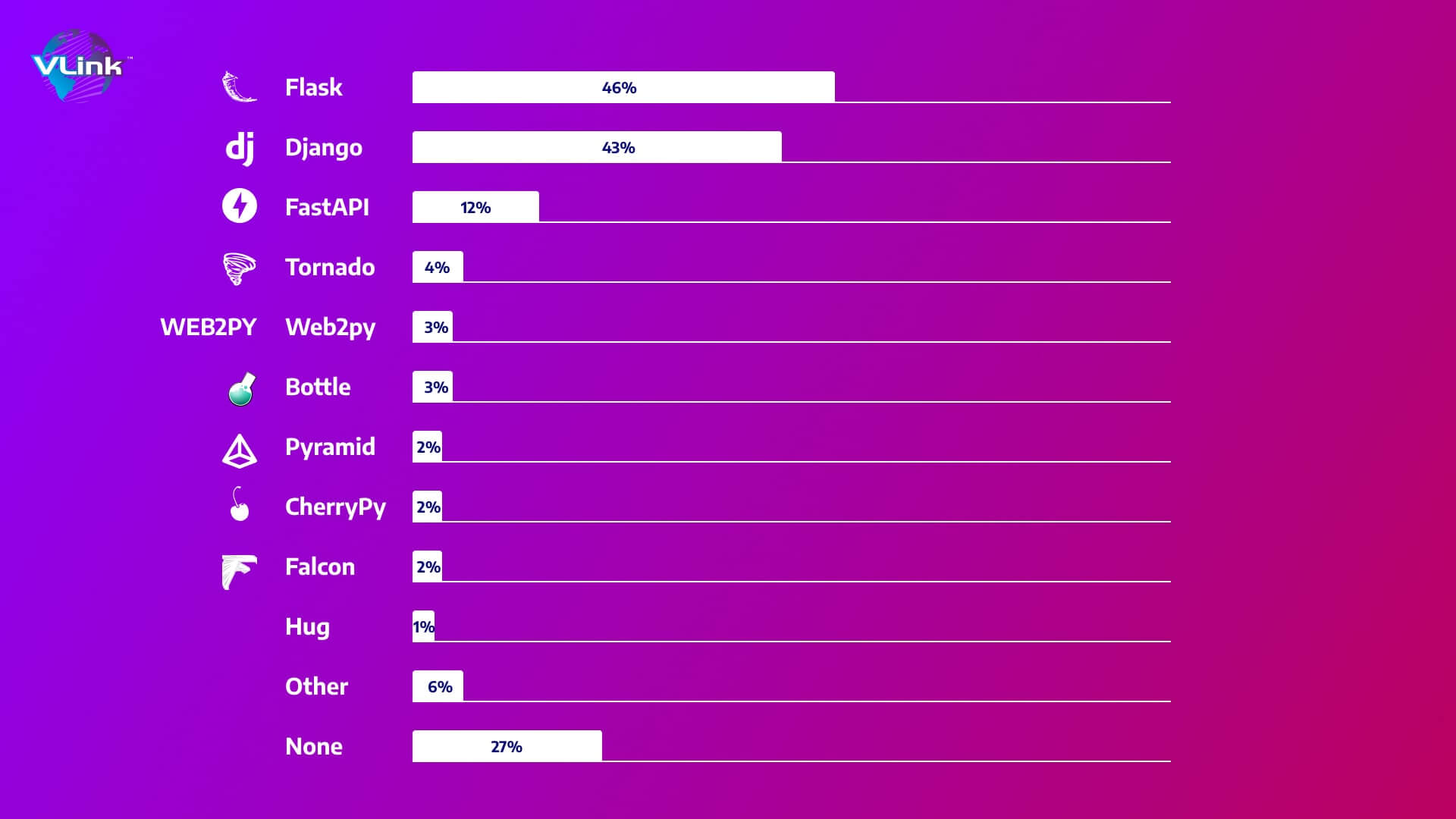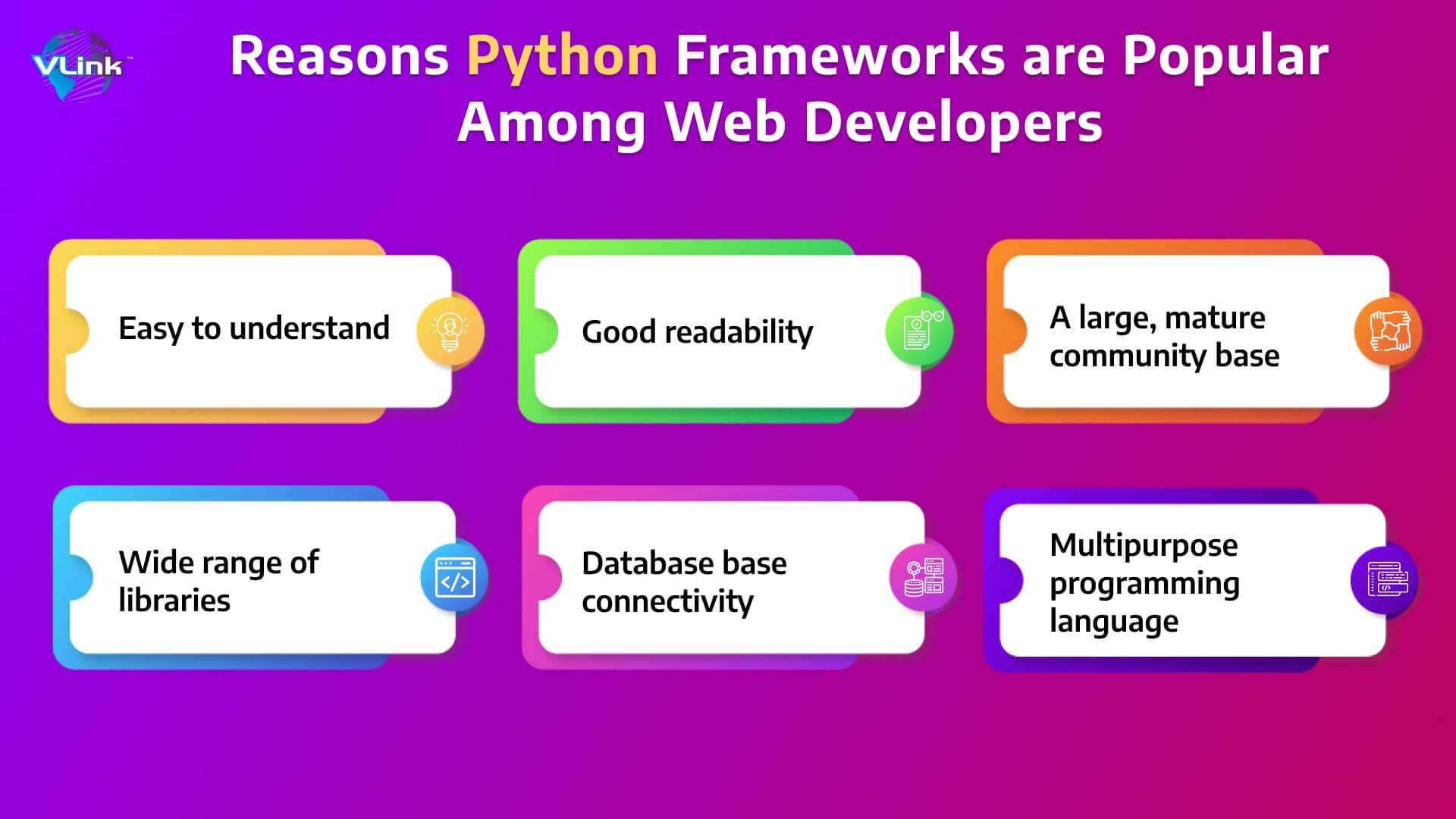Gone are the days when Java was the only popular programming language for leading developers. Python’s flexibility, popularity, and short learning curve have propelled it to the top position. The rise of Python web development has coincided with the growth of new technologies such as artificial intelligence, machine learning, and mobile and web app development.
Python provides several robust web development frameworks and libraries that can accelerate the development of server-side applications. In this blog, we’ll outline why Python is the top choice of web developers and enumerate the most popular frameworks used by Python software engineers today.
What is a Python Framework?
A Python framework is a set of modules that offers pre-built operational functionalities to reduce development time considerably. Using the proper framework, a Python development company can assist its developers in quickly constructing the application without wasting time on redundant low-level issues such as protocols, sockets, and thread management.
Unlike Python libraries, frameworks offer significantly more customizability, allowing developers to outline complex internal parts quickly.
Also Learn: How to choose custom website development company.
Top 12 Python Web Development Frameworks

What is Flask?
Flask is a lightweight micro-framework Python based on Werkzeug, Jinja 2 and good intentions. It allows developers to build solid web apps with any type of extension.
Key Features:
- Built-in development server and debugger
- Integrated code and unit testing support
- Uses Jinja2 template and Werkzeug WSGI toolkit
- Ability to plugin in ORM framework
Pros & Cons of Flask Framework:
Pros | Cons |
Scalable | No lots of tools |
Flexible | Difficult to get familiar with a larger Flask app |
Easy to Negotiate | Higher maintenance costs |
Lightweight | |
When to use Flask?
- If you are building small to medium-sized web apps.
- If you want to develop a rapid prototyping web app.
- If you need to create a restful API.
- If you are developing a microservices architecture.
- If you need to create custom web app development services or tools to perform specific tasks.
- If you want an excellent choice for teaching and learning web development concepts.
What is Django?
Django is a full-stack, free, open-source Python framework to build high-quality web apps from scratch. It’s widely used to create APIs and web apps. Approximately 12,000 projects are reported to have been made in it. Django is one of the most popular Python frameworks.
Key Features:
- A plethora of ready-to-use libraries
- Authentication support
- Database schema migrations
- Object-relational mapper (ORM)
- Support for web servers
- Template engine
- URL routing
Pros & Cons of Django Framework:
Pros | Cons |
Batteries included | No conventions |
Higher flexible | Not for smaller projects |
Faster development | Steep Learning Curve |
Machine learning capabilities | |
When to Use Django?
- If security is your priority.
- If you want to build a web service or an API-driven app.
- If you need a website or web app that requires a CMS (Content Management System).
- If you plan to build database-driven applications.
- If you are making a complex web app with multiple components and features.
FastAPI is a modern web development framework for building APIs with Python. It depends on Python to provide fast and efficient validation and documentation of Application Programming Interface requests and responses.
Key Features:
- High-performance libraries
- Simple and easy to use
- Easy validation and serialization
- Built-in documentation
- ASGI (Asynchronous Server Gateway Interface)support
Pros & Cons of FastAPI:
Pros | Cons |
Great performance | Insufficient security |
Built-in concurrency | Small developers' group |
Dependency injection support | |
Built-in docs | |
Validation built-in | |
When to Use FastAPI?
- If you need to build high-performance APIs.
- If your app needs to handle current tasks, such as multiple API calls or managing I/O operations.
- If data integrity and comprehensive documentation are essential for your project.
- If you're building real-time applications like chat applications, live dashboards, or collaborative tools.
- If your project involves serving machine learning models or data science-related computations through APIs.
What is Pyramid?
Pyramid allows programmers to build small & full-scale web apps in Python 3. Thanks to its adaptability, simplicity and scalability, it’s a popular Python web development platform. Mozilla, Yelp, Dropbox and SurveyMonkey are using this full-stack framework.
Key Features:
- Ability to run well with both small and large apps
- URL mapping based on Routes configuration through URL dispatch and WebHelpers
- HTML structure validation and generation
- All-embracing templating and asset details
- Testing, support, and comprehensive data documentation
- Flexible authentication and approval
Pros & Cons of Pyramid:
Pros | Cons |
Highly extensible and modular | Fewer pre-built libraries |
Flexible URL mapping system | Has a smaller developer community |
Number of built-in features | |
| |
When to use Pyramid?
- If you need to build custom web applications.
- If you're building a large and complex web application with a variety of components.
- If you need to create APIs with custom behaviors and endpoints.
- If you're working with an existing application or a legacy system.
- If your project requires WebSocket communication or real-time updates.
What is Bottle?
Fast, simple, and light, Bottle is a microframework that has few dependencies and collates everything into a single source file. It was initially designed to build APIs but also includes features such as routing, template, utilities, and a built-in HTTP server.
Key Features:
- Adapter support for 3rd-party template engines and WSGI/HTTP servers
- Allows simple access from cookies, data, file uploads, and other HTTP-related metadata
- Built-in HTTP server
- Plugin support for different databases
- Provides request-dispatching routes having URL-parameter support
Pros & Cons of Bottle:
Pros | Cons |
Lightweight and fast | Does not include built-in support |
Has small code base and minimal depedencies | Not best choice for large scale projects |
Supports various plugins and extensions | |
Easy accessible to newbie developers | |
When to Use Bottle?
- Excellent choice for building quick prototypes, proof-of-concept apps, or small projects.
- If you're building a RESTful API for your application or service.
- If you're looking for rapid development without having to deal with the complexities of larger frameworks.
- If you're building a web application with a particular purpose or a single functionality.
- If you're building lightweight backend services, such as data processing or simple utility services.
What is Tornado?
Tornado is an asynchronous Python web framework that simultaneously handles thousands of concurrent users with a non-blocking network I/O.
Key Features:
- Allows implementation of 3rd-party authentication and authorization schemes
- Offers high-quality output
- Real-time services
- Supports translation and localization
- User authentication support
- Web templating
Pros & Cons of Tornado:
Pros | Cons |
High-quality results | Not Ideal for All Applications |
Assistance in translation and localization | Limited Template Engine |
Support for user authentication and Web templates. | Limited Ecosystem |
When to use Tornado?
- Well-suited for building real-time applications.
- If you need to implement long-polling or Comet-style communication patterns.
- If you're building APIs that are expected to handle a high volume of requests simultaneously.
- Beneficial for applications that involve streaming and processing large amounts of data in real-time.
- If you're building an application that communicates using custom networking protocols or requires fine-grained control over network interactions.
What is BlueBream?
BlueBream boasts of competent component architecture, a transactional object database, integrated security protocols, and its server and library. This full-stack framework is best used to build medium and large applications.
Key Features:
- Well-tested core and third-party packages
- A unit and functional testing frameworks
- An automatic form-generation machinery
- A schema engine
- An XHTML-compliant templating language
- A flexible security architecture that provides a generic mechanism for pluggable security policies
Pros & Cons of BlueBream:
Pros | Cons |
Flexibility and Extensibility | Smaller Community |
Component-Based Architecture | Less Active Development |
Strong Security Features | |
Scalability | |
When to use BlueBream?
- Well-suited for building complex and customizable web applications.
- If your project requires a highly modular architecture.
- If your application has specific and complex security requirements.
- If you prefer to have fine-grained control over the components and libraries you use.
What is CherryPy?
A minimalist microframework, CherryPy allows you to build an entire application using the basic principles of object-oriented programming. It’s a lightweight, quick and stable Python web development framework.
This web framework can perform every function of a web framework, such as sessions, file uploads, static content and cookies.
Key Features:
- Several out-of-the-box tools for authentication, caching, encoding, sessions, static content, and much more
- A flexible built-in plugin system
- HTTP/1.1-compliant WSGI thread-pooled web server
- Inbuilt support for coverage, profiling, and testing
- It offers simplicity for running multiple HTTP servers simultaneously
- Powerful configuration system
- Runs on Android
Pros & Cons of CherryPy:
Pros | Cons |
Production-ready server | Lacks documentation |
A lot of functionality with dispatching templates | |
When to Use CherryPy?
- Well-suited for small to medium-sized projects.
- If you're building RESTful APIs.
- It can be used as a backend for single-page applications.
- If you're building high-performance applications.
What is Grok?
Grok was built upon the concrete programming adages of DRY and CoC. Don’t repeat yourself or DRY standardizes abstractions to avoid repetition, while convention over configuration or CoC gives developers a conventional foundation to work with.
Key Features:
- Offers a strong foundation for developing robust and extensible web applications.
- Enables web developers to take advantage of the power of Zope 3.
- A robust object database for storage.
- Integrated data security to ensure your application and grant access to specific users.
- Grok component architecture helps developers lessen the unpredictability of development.
- Offers the building blocks and other essential assets to develop custom web applications for business needs.
Pros & Cons of Grok:
Pros | Cons |
Zope 3’s capability | Not readability |
A strong object storage database | |
Integrated data security | |
When to use Grok?
- Well-suited for building complex web applications.
- If you're developing a content management system.
- If you or your team have experience with Zope or its concepts.
- For enterprise-level apps that need strong support for security, authentication, and authorization.
Data-driven and user-friendly, TurboGears doubles up as a full stack and a microframework. With several JS development tools, this Python web app development framework allows web programmers to streamline the construction of Python websites.
Key Features:
- Available command-line tools
- MochiKit JavaScript library integration
- Multi-database support
- MVC-style architecture
- PasteScript templates
- ToscaWidgets for simplifying the coordination of frontend design and server deployment
- Uses Pylons as a web server
- Validation support with FormEncode
Pros & Cons of TurboGears:
Pros | Cons |
Modular and component-based architecture | Smaller community |
Rapid development | Limited third-party integrations |
High flexibility | |
Community and documentation | |
When to use TurboGears?
- If your project's architecture requires a high degree of modularity and componentization.
- If you prefer having an integrated stack of tools and libraries without the need to configure and integrate various components manually.
- If you're working on a project that requires rapid development.
- Good choice for small to medium-sized projects.
What is Web2Py?
Web2Py is a dynamic and feature-loaded full-stack framework that does not require installation or configuration. It is cross-platform and has its own Integrated Development Engine.
Key Features:
- Backward compatibility
- Built-in data security for preventing several common vulnerabilities, including cross-site scripting, injection flaws, and malicious file execution
- Devoid of installation and configuration requirements
- Follows MVC-pattern
- Provides support for internationalization
- Readability of multiple protocols
- Role-based access control
Pros & Cons of Web2Py:
Pros | Cons |
It’s open-source, object-oriented | Inflexible plug-in system |
Scalable and integrated | No Python 3 support |
It has extensive libraries | System management difficulties |
Simple syntax | |
Automated development and testing | |
When to Use Web2Py?
- If you need to prototype and build a web application quickly.
- If you're new to web development or Python programming.
- Well-suited for small to medium-sized projects.
- If your application deals with sensitive data or requires robust security measures.
What is Dash?
This microframework works best for applications dabbling in machine learning services and data science and is usually used to build analysis-oriented Python applications.
Key Features:
- Dash apps demand very little boilerplate code to get started
- Error handling (Dash Deployment Server)
- High-degree of customization
- LDAP integration (Dash Deployment Server)
- Plugin support
- Simple interface for tying UI controls, including dropdowns, graphs, and sliders
- URL routing (Dash Deployment Server)
Pros & Cons of Dash:
Pros | Cons |
Customizable experience | Own visualization library |
Easily supports interactive visualizations | |
Huge & active community | |
When to use Dash?
If You need a high level of customization.
Why is Python so Popular with Web Developers?
The top software companies in the world widely use Python. Its modularity and flexibility make learning and implementing across various technologies and platforms more accessible. Reasons behind the popularity of Python web frameworks are shown in figure below:

Get Python Web Development Solution With VLink!
Choosing the proper framework for Python web development is not easy, especially if your organization needs to gain the requisite skill and expertise required to do so. And that’s where VLink’s Python developers’ team comes in.
By hiring Python developers from VLink, you can kickstart your project on the right note without worrying about talent acquisition and management. You can tap into a vast pool of experienced and talented remote software engineers to help you choose the proper framework and develop your application according to rigorous standards.
To learn more about our Python development services, contact us today.
Frequently Asked Questions
Python frameworks are divided into three categories based on scalability and required features.
Full stack framework
As the name suggests, full-stack frameworks cover both front-end and back-end development. Apart from tools for GUI design, such frameworks also encompass back-end services like databases, security protocols, and business logic.
An example of a full-stack development framework is Django, which is also incidentally the second most popular framework used by Python software engineers.
Microframework
Unlike full-stack frameworks, microframeworks are lightweight and flexible, giving developers more control over their applications.
With a simple yet extensible core, Python developers can add third-party libraries when needed without committing beforehand. Bottle and CherryPy frameworks come under this category.
Asynchronous framework
Asynchronous, non-blocking code lets developers work with concurrent connections via an async-capable server. Sanic and Tornado are the top examples in this category.
Django is a full-stack, opinionated framework with built-in features and an admin interface, suitable for larger projects. Flask is a micro-framework offering flexibility and modularity for smaller to medium-sized projects.
Django's learning curve is steeper, while Flask provides a more straightforward, customizable approach. The choice depends on project size and developer preferences.
Django is a back-end framework for building web applications. It handles server-side operations, data processing, and database interactions, leaving front-end development to other tools or frameworks.








